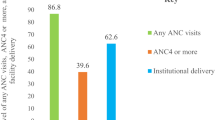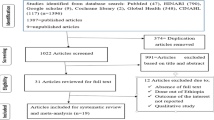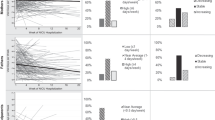Abstract
Objective:
The objective of the study was to determine the association of home visiting with subsequent pregnancy outcomes.
Study Design:
Retrospective study of Ohio mothers delivering their first infant from 2007 to 2009. First, we compared mothers enrolled in home visiting with a matched eligible group. Second, we compared outcomes within home visiting based on program participation (low <25% of recommended home visits, moderate 25 to 75%, high 75 to 100% and very high >100%). Time to subsequent pregnancy within 18 months was evaluated using Cox proportional hazards regression; logistic regression tested the likelihood of subsequent preterm birth.
Results:
Of 1516 participants, 1460 were matched 1:1 to a comparison mother (n=2920). After multivariable adjustment, enrollment was associated with no difference in pregnancy spacing or subsequent preterm birth. Among those enrolled, moderate vs low participants had reduced risk of repeat pregnancy over 18 months (hazard ratio 0.68, P=0.003).
Conclusion:
Increased pregnancy spacing is observed among women with at least moderate home visiting participation.
This is a preview of subscription content, access via your institution
Access options
Subscribe to this journal
Receive 12 print issues and online access
$259.00 per year
only $21.58 per issue
Buy this article
- Purchase on Springer Link
- Instant access to full article PDF
Prices may be subject to local taxes which are calculated during checkout

Similar content being viewed by others
References
Institute of Medicine (U.S.) Committee on Understanding Premature Birth and Assuring Healthy Outcomes Preterm Birth: Causes, Consequences, and Prevention. National Academies Press: Washington, D.C., USA, 2006.
Health Resources and Services Administration. Maternal, Infant, and Early Childhood Home Visiting Program. 2010. Available at http://mchb.hrsa.gov/programs/homevisiting (cited on 1 September 2011).
Larson K, Russ SA, Crall JJ, Halfon N . Influence of multiple social risks on children's health. Pediatrics 2008; 121 (2): 337–344.
U.S. Department of Health and Human Services. Home Visiting Evidence of Effectiveness. Available at http://homvee.acf.hhs.gov/ (cited on 31 January 2013).
Donovan EF, Ammerman RT, Besl J, Atherton H, Khoury JC, Altaye M et al. Intensive home visiting is associated with decreased risk of infant death. Pediatrics 2007; 119 (6): 1145–1151.
Kitzman H, Olds DL, Henderson CR Jr, Hanks C, Cole R, Tatelbaum R et al. Effect of prenatal and infancy home visitation by nurses on pregnancy outcomes, childhood injuries, and repeated childbearing. A randomized controlled trial. JAMA 1997; 278 (8): 644–652.
Lee E, Mitchell-Herzfeld SD, Lowenfels AA, Greene R, Dorabawila V, DuMont KA . Reducing low birth weight through home visitation: a randomized controlled trial. Am J Prev Med 2009; 36 (2): 154–160.
Reece EA, Leguizamon G, Silva J, Whiteman V, Smith D . Intensive interventional maternity care reduces infant morbidity and hospital costs. J Matern Fetal Neonatal Med 2002; 11 (3): 204–210.
Wells N, Sbrocco T, Hsiao CW, Hill LD, Vaughn NA, Lockley B . The impact of nurse case management home visitation on birth outcomes in African-American women. J Natl Med Assoc 2008; 100 (5): 547–552.
Filene JH, Kaminski JW, Valle LA, Cachat P . Components associated with home visiting program outcomes: a meta-analysis. Pediatrics 2013; 132 (Suppl 2): S100–S109.
Slaughter JC, Issel LM . Developing a measure of prenatal case managementdosage. Matern Child Health J 2012; 16 (5): 1120–1130.
Roman L, Raffo JE, Zhu Q, Meghea CI . A statewide medicaid enhanced prenatal care program: impact on birth outcomes. JAMA Pediatr 2014; 168 (3): 220–227.
Goyal NK, Hall ES, Meinzen-Derr JK, Kahn RS, Short JA, Van Ginkel JB et al. Dosage effect of prenatal home visiting on pregnancy outcomes in at-risk, first-time mothers. Pediatrics 2013; 132 (Suppl 2): S118–S125.
Goyal NK, Folger AT, Hall ES, Teeters A, Van Ginkel JB, Ammerman RT . Multilevel assessment of prenatal engagement in home visiting. J Epidemiol Community Health 2016; 70 (9): 888–894.
DeFranco EA, Ehrlich S, Muglia LJ . Influence of interpregnancy interval on birth timing. BJOG 2014; 121 (13): 1633–1640.
Nabukera SK, Wingate MS, Owen J, Salihu HM, Swaminathan S, Alexander GR et al. Racial disparities in perinatal outcomes and pregnancy spacing among women delaying initiation of childbearing. Matern Child Health J 2009; 13 (1): 81–89.
Smith GC, Pell JP, Dobbie R . Interpregnancy interval and risk of preterm birth and neonatal death: retrospective cohort study. BMJ 2003; 327 (7410): 313.
Polit DF, Kahn JR . Early subsequent pregnancy among economically disadvantaged teenage mothers. Am J Public Health 1986; 76 (2): 167–171.
El-Kamary SS, Higman SM, Fuddy L, McFarlane E, Sia C, Duggan AK . Hawaii's healthy start home visiting program: determinants and impact of rapid repeat birth. Pediatrics 2004; 114 (3): e317–e326.
Rubin DM, O’Reilly AL, Luan X, Dai D, Localio AR, Christian CW . Variation in pregnancy outcomes following statewide implementation of a prenatal home visitation program. Arch Pediatr Adolesc Med 2011; 165 (3): 198–204.
Sonalkar S, Mody S, Gaffield ME . Outreach and integration programs to promote family planning in the extended postpartum period. Int J Gynaecol Obstet 2014; 124 (3): 193–197.
Yun K, Chesnokova A, Matone M, Luan X, Localio AR, Rubin DM . Effect of maternal-child home visitation on pregnancy spacing for first-time Latina mothers. Am J Public Health 2014; 104 (Suppl 1): S152–S158.
Daro DA, Harding KA . Healthy Families America: using research to enhance practice. Future Child 1999; 9 (1): 152–178.
Olds DL, Hill PL, O’Brien R, Racine D, Moritz P . Taking preventive intervention to scale: the Nurse-Family Partnership. 2003 Cogn Behav Pract 10 (4): 278–290.
Ammerman RT, Putnam FW, Kopke JE, Gannon TA, Short JA, Van Ginkel JB et al. Development and implementation of a quality assurance infrastructure in a multisite home visitation program in Ohio and Kentucky. J Prev Interv Community 2007; 34 (1–2): 89–107.
Hall ES, Goyal NK, Ammerman RT, Miller MM, Jones DE, Short JA et al. Development of a linked perinatal data resource from state administrative and community-based program data. Matern Child Health J 2014; 18 (1): 316–325.
Goyal NK, Hall ES, Jones DE, Meinzen-Derr JK, Short JA, Ammerman RT et al. Association of maternal and community factors with enrollment in home visiting among at-risk, first-time mothers. Am J Public Health 2014; 104 (Suppl 1): S144–S151.
D’Agostino RB Jr . Propensity score methods for bias reduction in the comparison of a treatment to a non-randomized control group. Stat Med 1998; 17 (19): 2265–2281.
Austin PC . Some methods of propensity-score matching had superior performance to others: results of an empirical investigation and Monte Carlo simulations. Biom J 2009; 51 (1): 171–184.
Bergstralh E, Kosanke J . GMATCH. 2003 Available at http://www.mayo.edu/research/departments-divisions/department-health-sciences-research/division-biomedical-statistics-informatics/software/locally-written-sas-macros (cited on 14 September 14 2013).
Daro D, Hart B, Boller K, Bradley MC Replicating Home Visiting Programs with Fidelity: Baseline Data and Preliminary Findings. Children’s Bureau, Administration for Children and Families, U.S. Department of Health and Human Services. 2012 December. Contract No.: GS-10F-0050 L/HHSP233200800065W. Mathematica Policy Research: Princeton, NJ, USA.
Duggan A, McFarlane E, Fuddy L, Burrell L, Higman SM, Windham A et al. Randomized trial of a statewide home visiting program: impact in preventing child abuse and neglect. Child Abuse Negl 2004; 28 (6): 597–622.
Kotelchuck M . The Adequacy of Prenatal Care Utilization Index: its US distribution and association with low birthweight. Am J Public Health 1994; 84 (9): 1486–1489.
Holland ML, Xia Y, Kitzman HJ, Dozier AM, Olds DL . Patterns of visit attendance in the nurse-family partnership program. Am J Public Health 2014; 104 (10): e58–e65.
mmerman RT . Toward the next generation of home visiting programs: new developments and promising directions. Curr Probl Pediatr Adolesc Health Care 2016; 46 (4): 126–129.
Ammerman RT, Stevens J, Putnam FW, Altaye M, Hulsmann JE, Lehmkuhl HD et al. Predictors of early engagement in home visitation. J Fam Violence 2006; 21 (2): 105–115.
Acknowledgements
We acknowledge the participation and support of the United Way of Greater Cincinnati and Ohio Help Me Grow. We also thank Dr Louis Muglia for his critical review of the manuscript. NKG was supported by the Building Interdisciplinary Research Careers in Women’s Health program (5K12HD051953-07), co-funded by the Office of Research on Women’s Health (ORWH) and the Eunice Kennedy Shriver National Institute of Child Health and Human Development (NICHD), administered by the Center for Clinical and Translational Science and Training at University of Cincinnati. The content (including study design, data collection, analysis and interpretation of data, writing of the report and decision to submit the article for publication) is solely the responsibility of the authors and does not necessarily represent the official views of the National Institutes of Health.
Author information
Authors and Affiliations
Corresponding author
Ethics declarations
Competing interests
The authors declare no conflict of interest.
Rights and permissions
About this article
Cite this article
Goyal, N., Folger, A., Hall, E. et al. Home visiting for first-time mothers and subsequent pregnancy spacing. J Perinatol 37, 144–149 (2017). https://doi.org/10.1038/jp.2016.192
Received:
Revised:
Accepted:
Published:
Issue Date:
DOI: https://doi.org/10.1038/jp.2016.192
This article is cited by
-
Birth-Related Outcomes for Second Children Following Home Visiting Program Enrollment for New Parents of First Children
Maternal and Child Health Journal (2022)
-
Interpregnancy Interval and Birth Outcomes: A Propensity Matching Study in the California Population
Maternal and Child Health Journal (2022)
-
Low birthweight in second children after nurse home visiting
Journal of Perinatology (2018)



